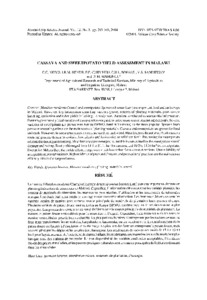| dc.contributor.author | Moyo, C.C. |
| dc.contributor.author | Benesi, I.R.M. |
| dc.contributor.author | Chipungu, F.P. |
| dc.contributor.author | Mwale, C.H.L. |
| dc.contributor.author | Sandifolo, V.S. |
| dc.contributor.author | Mahungu, N.M. |
| dc.date.accessioned | 2019-12-04T11:23:35Z |
| dc.date.available | 2019-12-04T11:23:35Z |
| dc.date.issued | 2004 |
| dc.identifier.citation | Moyo, C.C., Benesi, I.R.M., Chipungu, F.P., Mwale, C.H.L., Sandifolo, V.S. & Mahungu, N.M. (2004). Cassava and sweetpotato yield assessment in Malawi. African Crop Science Journal, 12(3), 295-303. |
| dc.identifier.issn | 1021-9730 |
| dc.identifier.uri | https://hdl.handle.net/20.500.12478/4045 |
| dc.description.abstract | Cassava (Manihot esculenta Crantz) and sweetpotato (Ipomoea batatas Lam) are important food and cash crops in Malawi. However, key information regarding varieties grown, sources of planting materials, post-harvest handling, utilisation and tuber yields is lacking. A study was, therefore, conducted to source this information. Farmers grow mostly local varieties of cassava with own gardens as the main source of planting materials. Several varieties of sweetpotato are grown with Kenya (SPN/O, bred in Tanzania) as the most popular. Sprouts from previous season\'s gardens are the main source of planting materials. Cassava and sweetpotato are grown for food and cash. However, in some area cassava stems are used for fuel wood. Most farmers do not store fresh cassava roots but process them into makaka, kanyakaska and kadonoska, or sell them fresh. Processing for sweetpotato is limited to boiling and roasting. Most farmers store sweetpotato, but this is constrained by the sweetpotato weevil damage and rotting. Root yield ranged from 13.1 to 31.4 t ha-1 for cassava, and 10.2 to 14.0 t ha-1 for sweetpotato. Except for Nkhata Bay, the yields of both crops were much lower than from research stations. Unavailability of acceptable improved varieties, high incidence of pests and diseases, and poor cultural practices are the main causes of low yields in the targeted areas |
| dc.description.abstract | Le manioc (Manihot esculenta Crantz) et la patate douce (Ipomoea batatas Lam) sont des importants aliments et plantes génératrices de ressources en Malawi. Cependant, l\'information clé concernant les variétés plantées, les sources de matériels de plantation, les manœuvres post-récoltes, l\'utilisation et les rendements de tubercules manque. Une étude était alors conduite pour approvisionner cette information. Les fermiers cultivent souvent les variétés locales de manioc avec comme source principale de matériels de plantation leurs propres champs. Plusieurs variétés de patate douce sont cultivées au Kenya (SPN/O, conditionnée en Tanzanie) comme le plus populaire. Les germes des champs de saison précédente sont la source principale de matériels de plantation. Le manioc et patate douce sont cultivés pour la nourriture et l\'argent. Cependant, dans certaines aires les tiges de manioc sont utilisées pour le bois de chauffe. La plus part des fermiers n\'entreposent pas les racines de manioc frais mais transforment les en makaka, kanyakaska et kadonoska, ou les vendent frais. La transformation de la patate douce est limitée à l\'ébullition et au rôtissage. La plus part des fermiers entreposent la patate douce, mais ceci est gêné par les dégâts et les avaries des charançons. Les rendements de racines ont variés de 13.1 a 13.4 t ha-1 pour la patate douce. A l\'exception de laurier Nkhata, les rendements des toutes les deux cultures étaient plus bas que ceux des stations de recherche. La non disponibilité des variétés améliorées acceptables, l\'incidence élevée des pestes et maladies, et les pauvres pratiques culturales sont les causes principales de faibles rendements dans les aires visées. |
| dc.description.sponsorship | United States Agency for International Development |
| dc.language.iso | en |
| dc.language.iso | fr |
| dc.subject | Ipomoea Batatas |
| dc.subject | Manihot Esculenta |
| dc.subject | Planting Materials |
| dc.subject | Weevil |
| dc.subject | Ipomoea Batatas |
| dc.subject | Manihot Esculenta |
| dc.subject | Matériel De Plantation |
| dc.subject | Charançon |
| dc.title | Cassava and sweetpotato yield assessment in Malawi |
| dc.type | Journal Article |
| dc.description.version | Peer Review |
| cg.contributor.crp | Roots, Tubers and Bananas |
| cg.contributor.crp | Agriculture for Nutrition and Health |
| cg.contributor.affiliation | Ministry of Agriculture and Irrigation, Malawi |
| cg.contributor.affiliation | International Institute of Tropical Agriculture |
| cg.coverage.region | Africa |
| cg.coverage.region | Southern Africa |
| cg.coverage.country | Burkina Faso |
| cg.coverage.country | Mali |
| cg.authorship.types | CGIAR and developing country institute |
| cg.iitasubject | Cassava |
| cg.iitasubject | Pests Of Plants |
| cg.accessibilitystatus | Limited Access |
| local.dspaceid | 99331 |
| cg.identifier.doi | https://doi.org/10.4314/acsj.v12i3.27891 |

